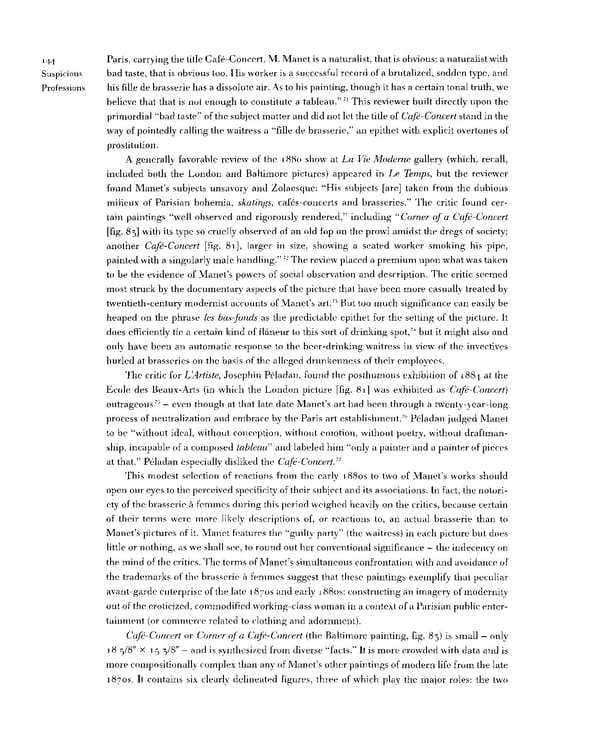144 Paris, carrying the title Cafe-Concert. M. Manet is a naturalist, that is obvious; a naturalist with Suspicious bad taste, that is obvious too. His worker is a successful record of a brutalized, sodden type, and Professions his fille de brasserie has a dissolute air. As to his painting, though it has a certain tonal truth, we 71 believe that that is not enough to constitute a tableau." This reviewer built directly upon the primordial "bad taste" of the subject matter and did not let the title of Cafe-Concert stand in the way of pointedly calling the waitress a "fille de brasserie," an epithet with explicit overtones of prostitution. A generally favorable review of the 1880 show at La Vie Moderne gallery (which, recall, included both the London and Baltimore pictures) appeared in Le Temps, but the reviewer found Manet's subjects unsavory and Zolaesque: "His subjects [are] taken from the dubious milieux of Parisian bohemia, skatings, cafes-concerts and brasseries." The critic found cer- tain paintings "well observed and rigorously rendered," including "Corner of a Cafe-Concert [fig. 83] with its type so cruelly observed of an old fop on the prowl amidst the dregs of society; another Cafe-Concert [fig. 81], larger in size, showing a seated worker smoking his pipe, 72 painted with a singularly male handling." The review placed a premium upon what was taken to be the evidence of Manet's powers of social observation and description. The critic seemed most struck by the documentary aspects of the picture that have been more casually treated by twentieth-century modernist accounts of Manet's art.73 But too much significance can easily be heaped on the phrase les bas-fonds as the predictable epithet for the setting of the picture. It 74 does efficiently tie a certain kind of flaneur to this sort of drinking spot, but it might also and only have been an automatic response to the beer-drinking waitress in view of the invectives hurled at brasseries on the basis of the alleged drunkenness of their employees. The critic for UArtiste, Josephin Peladan, found the posthumous exhibition of 1884 at the Ecole des Beaux-Arts (in which the London picture [fig. 81] was exhibited as Cafe-Concert) 75 outrageous — even though at that late date Manet's art had been through a twenty-year-long 76 process of neutralization and embrace by the Paris art establishment. Peladan judged Manet to be "without ideal, without conception, without emotion, without poetry, without draftman- ship, incapable of a composed tableau" and labeled him "only a painter and a painter of pieces at that." Peladan especially disliked the Cafe-Concert77 This modest selection of reactions from the early i88os to two of Manet's works should open our eyes to the perceived specificity of their subject and its associations. In fact, the notori- ety of the brasserie a femmes during this period weighed heavily on the critics, because certain of their terms were more likely descriptions of, or reactions to, an actual brasserie than to Manet's pictures of it. Manet features the "guilty party" (the waitress) in each picture but does little or nothing, as we shall see, to round out her conventional significance — the indecency on the mind of the critics. The terms of Manet's simultaneous confrontation with and avoidance of the trademarks of the brasserie a femmes suggest that these paintings exemplify that peculiar avant-garde enterprise of the late 18708 and early i88os: constructing an imagery of modernity out of the eroticized, commodified working-class woman in a context of a Parisian public enter- tainment (or commerce related to clothing and adornment). Cafe-Concert or Corner of a Cafe-Concert (the Baltimore painting, fig. 83) is small — only 18 5/8" X 15 3/8" — and is synthesized from diverse "facts." It is more crowded with data and is more compositionally complex than any of Manet's other paintings of modern life from the late 18708. It contains six clearly delineated figures, three of which play the major roles: the two
 Prostitution & Impressionists Page 164 Page 166
Prostitution & Impressionists Page 164 Page 166